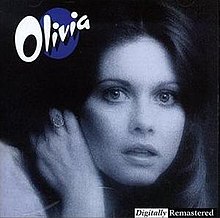| Olivia | ||||
|---|---|---|---|---|
 | ||||
| Studio album by | ||||
| Released | 11 August 1972 | |||
| Recorded | 1972 | |||
| Studio | Abbey Road, Studio 2, London | |||
| Genre | ||||
| Length | 40:38 | |||
| Label | Festival | |||
| Producer | Bruce Welch, John Farrar | |||
| Olivia Newton-John chronology | ||||
| ||||
| Singles from Olivia | ||||
| ||||
Olivia (released in Continental Europe as Olivia Newton-John) is the second studio album by the British-Australian singer-songwriter Olivia Newton-John, released in 1972. Two of its songs were released as singles ("What Is Life" and "Just a Little Too Much"). It was never issued in the United States, where just four of its songs would instead eventually be released on Let Me Be There and If You Love Me, Let Me Know. Festival Records in Australia re-released Olivia in combination with Newton-John's first solo album, If Not For You, as a two-record set in 1973 on the Interfusion label, simply titled Olivia Newton-John, with a cover photo taken in 1972. Olivia wasn't released on CD until 1990, when EMI in Japan issued it on their Pastmasters series. It was finally released in a digitally remastered version by Festival Records Pty Ltd (Aust) in 1998. Fans in the United States had to obtain one of these CD versions as an import, as the album has never been released there.
She covers two songs from George Harrison on this album, "Behind That Locked Door" and "What Is Life", both from Harrison's first solo album, All Things Must Pass, published in 1970. Other noteworthy songs on the album include her rendition of Chip Taylor's "Angel of the Morning", David Gates's "Everything I Own" and Newton-John's own "Changes". The last found its way into Newton-John's live performances and remained there at least through the late 1970s. It was featured during her November 1978 Live in Amsterdam concert which was broadcast in the Netherlands. She also performed it live on the Merv Griffin show that year. And it was included on Newton-John's first greatest hits collection in the United States at the end of 1977.
The cover art, done in blue tint, was later used (in a blueish-green tint) as the cover of the US release of Let Me Be There on MCA Records in 1973, following the success of the hit single penned by John Rostill.